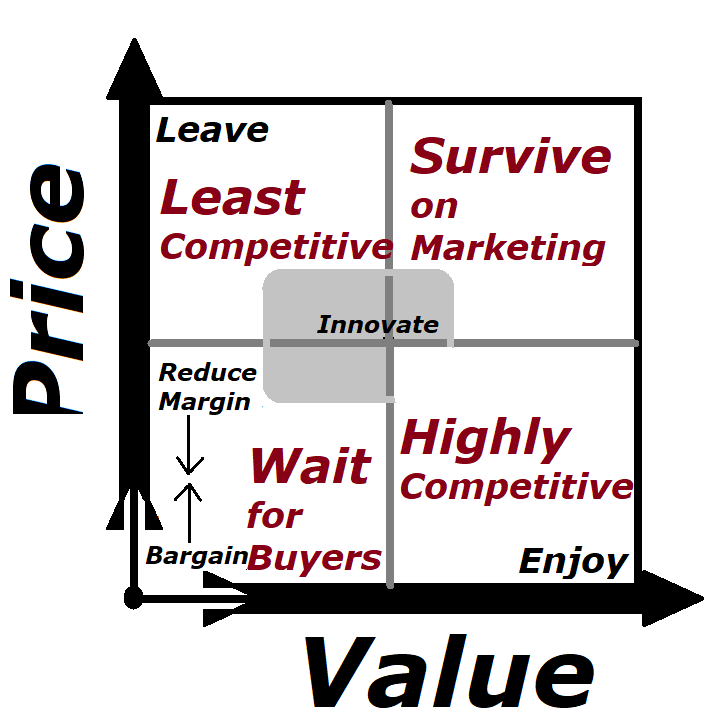BAG stands for Bargain And Grow ! BAG is me Bharati Abhijit Goraksha !
Have you ever wondered how different businesses are using different strategies and still few are doing extremely well and majority fails. Few people fail even after copying a successful business ! I hope you will find many of your answers here. And if you find it do not forget to comment and let the world know !
Answer to a top concern of a business owner or an entrepreneur is given below. I want to be nice to you by telling this 10000 crore worth methodology in a free publication. I need a promise from you that you will share it to all entrepreneurs who are willing to improvise.

SWOT analysis is a buzz word in business domain and more so in B-schools. I assume here you know your business well and you know what strengths , weaknesses , opportunities and threats your business posses.
Going a step further we arrive at product level decisions. Every single product is important for any business. Its a baby of an entrepreneur !
How to calculate price and value of a product?
Below is a step by step guide to arrive at a statistically correct price and value. There are certain assumptions I have made , but let us focus on the core concept. Hundreds of pages of research is always summarized for C level executives.
That’s the reason I said above picture is worth 10000 crore. If you understand the basics, hundreds of pages can be built around it for less than a crore.
Y Axis: Vertical line represents price.
X-Axis: Horizontal line represents value which customer derives out of the product or service.
Method of arriving at results: A: Price 1. Please choose a statistically valid sample of similar products. Let’s say we have a sample of 10 products of which one is our companies product and 9 are competitor products. 2. If you are studying car as a product and if car prices range from 2 lac to 30 lac, your Y-axis to be marked from 0 to 30 with 30 price intervals. One interval for every one lac of rupee.
B. Value 3. Random group of 100 people can be taken as a test sample who can be our customers or users of the product. (Higher samples might be required in certain cases). 4. Do not inform price of product to these 100 people. 5. Let all of them use all products and take a rank from 1 to 10 for all products they used. 6. A product which received highest rank should be assigned a value of 10. 7. Product which receives lowest value should be assigned value of 1.
C. Plotting 8. Now simply a mark needs to be put on above graph with corresponding figure of price and value.
Interpretation:
Depending upon where is a dot appearing for your product and also where are the dot for other products, you need to fix the above matrix so that there is a proper coverage. Your dot might be in one of the below squares.
- Leave / Least Competitive :
Top most position and a left corner gives a “Leave” signal. There is no point in continuing that product. If product is slightly at right side but in top left square it is a clear indication that product is “Least Competitive”. Naturally focus should be on adding value and reducing price both at the same time.
- Survive on marketing :
Top right corner indicates almost all MNC products and top selling brands which are actually surviving on advertising. There is a natural balancing which happens and a product with lesser value will do lesser advertising as effect of advertising works better for a better product. Rather job of a marker is tough when product is at a left side of top right quadrant as marketer would be required to create a value perception out of advertising.
- Reduce margin / bargain / wait for buyers :
Bottom and a left most side is identical to a scrap. Scrap is a throw away , may be old newspaper or broken utensils. Bargaining for a high price is the best strategy as it appears to me. A left most side but slightly higher is a “Reduce Margin” point. Here though the value is missing product still carries a small price. Owner is obsessed with her product and think its a nice one. But market does not value it. A good way to get buyer is to reduce the margin. At the bottom but slightly to the right is a wait for buyers. Here value is slightly higher at a lower price. Though a large value product exists in market, waiting for buyer is what pays off to businesses during a peak season.
Now you know why plenty of businesses are waiting for “Diwali” . (“Diwali” is the biggest selling period for Indian businesses).
- Enjoy :
If your product is at a bottom right position you are simply rocking. It appears these are the products which do not require a high priced consultancy. But in reality these product owners are the one who invest either their own brains or of a consultant to reach the place of enjoyment.
- Innovate :
Center of all is innovation ! Highly competitive products always use innovation as a base. If power of innovation is strong enough no matter where the product is at present, it can achieve a highly competitive status in future.
My suggestion to a new venture:
Typical new product or service stands at left most part on the horizontal X-axis with little value. I suggest a move from “Bargain” to “Wait for Buyers” by adding extra value and being more competitive. A step further would be a move from “Wait for Buyers” to become “Highly Competitive”.
I have seen many start-ups who reach “Wait for Buyers” stage and finally decide to get out of the product or service. They then “Wait for Buyers” for their start-up.
